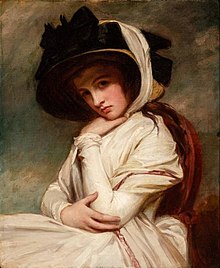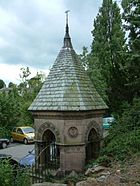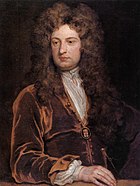Portal:Cheshire
|
The Cheshire Portal
WelcomeCheshire Plain from the Mid Cheshire Ridge
Cheshire is a ceremonial county in the North West of England. Chester is the county town, and formerly gave its name to the county. The largest town is Warrington, and other major towns include Congleton, Crewe, Ellesmere Port, Macclesfield, Nantwich, Northwich, Runcorn, Sandbach, Widnes, Wilmslow and Winsford. The county is administered as four unitary authorities. Cheshire occupies a boulder clay plain (pictured) which separates the hills of North Wales from the Peak District of Derbyshire. The county covers an area of 2,343 km2 (905 sq mi), with a high point of 559 m (1,834 ft) elevation. The estimated population is a little over one million, 19th highest in England, with a population density of around 450 people per km2. The county was created in around 920, but the area has a long history of human occupation dating back to before the last Ice Age. Deva was a major Roman fort, and Cheshire played an important part in the Civil War. Predominantly rural, the county is historically famous for the production of Cheshire cheese, salt and silk. During the 19th century, towns in the north of the county were pioneers of the chemical industry, while Crewe became a major railway junction and engineering facility. Selected articleChester Canal is a former canal linking the River Dee at Chester with Nantwich. It now forms part of the Shropshire Union Canal. The original intention was to construct a main line from Chester to Middlewich, with a branch to Nantwich, but Francis Egerton, Duke of Bridgewater, opposed a direct link with the Trent and Mersey Canal at Middlewich. Construction began in 1772, and the route was opened through to Nantwich in 1779. At first unsuccessful, it was linked first to the Ellesmere Canal in 1797 and then the Llangollen Canal in 1805, so that the original Chester Canal formed the middle section of a profitable canal. The Middlewich Branch finally opened in 1833, and the canal operated successfully into the 20th century. The canal passes alongside Chester city walls in a deep, vertical red sandstone cutting, and the route then runs broadly south-east, passing via Christleton, Beeston and Bunbury before reaching Nantwich Basin. It crosses the River Gowy via an aqueduct. Beeston Iron Lock, built using cast iron plates by Thomas Telford in 1828, is unique in England. Selected imageEmma, Lady Hamilton (1761–1815), best known as the mistress of Horatio Nelson, was born at Ness, the daughter of a blacksmith. Renowned for her beauty, she became the muse of portraitist George Romney, inspiring more than 60 pictures. This portrait dates from 1785. In this month1 December 1901: Artist and illustrator Charles Tunnicliffe born in Langley. 1 December 1906: Carnegie Library, Runcorn officially opened. 6 December 1891: Rowland Egerton-Warburton died at Arley Hall. 8 December 1665: Civil War diarist Edward Burghall died at Alpraham. 9 December 1836: Dutton Viaduct completed. 10 December 1583: Great Fire of Nantwich started. 13 December 1643: Siege of Nantwich started. 14 December 1979: Footballer Michael Owen born in Chester. 17 December 1925: Cricketer A. N. Hornby (gravestone pictured) died in Nantwich. 17 December 1973: Long-distance runner Paula Radcliffe born in Davenham. 19 December 1572: Landlord of Nantwich's Crown Inn murdered; the investigation involved many among the town's gentry. 22 December 1643: Royalist forces occupied Audlem, Brindley, Buerton, Hankelow, Hatherton, Hurleston, Stoke and Wrenbury during the Civil War. 23 December 1642: Bunbury Agreement drawn up. 24 December 1643: Twelve Parliamentarians massacred at St Bertoline's Church, Barthomley. 26 December 1643: Second Battle of Middlewich during the Civil War. 26 December 1962: Train crash at Coppenhall, between Crewe and Winsford, killed 18 people and injured 34. 29 December 1940: Air raid badly damaged the Crewe Rolls Royce works and killed 16 employees. Selected listThe output of Chester-based architect John Douglas (1830–1911) included a diverse range of non-residential works. The majority of his works were in Cheshire and North Wales. His architectural styles were eclectic, but as he worked during the Gothic Revival period much of his output incorporates elements of the English Gothic style. He is probably best remembered for his incorporation of vernacular elements in his buildings, especially half-timbering, but also tile-hanging, pargeting, and decorative brickwork in diapering and tall chimney stacks. In addition to numerous churches, Douglas's non-residential works included a great variety of buildings such as schools, shops, offices, hotels, public houses, banks, model farms, cheese factories, a gentlemen's club, a public baths and a public convenience. The Eastgate Clock in Chester, a memorial of Queen Victoria's Diamond Jubilee, is perhaps the best known of the smaller commissions he undertook. Other examples include memorials, a canopy over a well (pictured), a temporary triumphal arch, a garden ornament and an obelisk. GeographyTop: Map of modern Cheshire showing urban areas (grey) and the major road network. Chester (red) is the county town, and Warrington has the greatest population. Towns with more than 10,000 inhabitants in 2011 are highlighted; the size of dot gives a rough indication of the relative population. Wales and the adjacent English counties are shown in capitals. Bottom: Relief map showing the major hills. The Mid Cheshire Ridge is a discontinuous ridge of low hills running north–south from Beacon Hill (north of Helsby Hill) to Bickerton Hill. Most other high ground falls within the Peak District in the east of the county. Shining Tor (559 metres), on the boundary with Derbyshire, forms the county's high point. Administration The ceremonial county of Cheshire is administered by four unitary authorities (click on the map for details): 2 – Cheshire East 3 – Warrington 4 – Halton In the local government reorganisation of 1974, Cheshire gained an area formerly in Lancashire including Widnes and Warrington. The county lost Tintwistle to Derbyshire, part of the Wirral Peninsula to Merseyside, and a northern area including Stockport, Altrincham, Sale, Hyde, Dukinfield and Stalybridge to Greater Manchester. Selected biographySir John Vanbrugh (1664 – 26 March 1726) was an English architect and dramatist. Born in London, he grew up in Chester. As a young man and a committed Whig, he was involved in a plot to overthrow James II, put William III on the throne and protect English parliamentary democracy. His actions led to his imprisonment as a political prisoner in the Bastille. As an architect, Vanbrugh created what came to be known as English Baroque. He designed Blenheim Palace and Castle Howard. His architectural work was bold and daring, and jarred conservative opinions on the subject. His two argumentative and outspoken Restoration comedies, The Relapse (1696) and The Provoked Wife (1697) have become enduring stage favourites, although they originally occasioned much controversy. Vanbrugh offended many sections of Restoration and 18th century society, not only by the sexual explicitness of his plays, but also by their messages in defence of women's rights in marriage. Did you know...
Selected town or villageSound is a small settlement and civil parish near Nantwich. The parish covers 1,089 acres (441 ha) and also includes Newtown and Sound Heath, with a total population of around 240 in 2011. The name is of Saxon origin and means "a sandy place". The first record of the township is in 1310. It was raided by Royalist forces in 1643, during the Civil War. The Methodist chapel was built in 1838, and a primary school on the boundary with Broomhall opened in 1876. Other historic buildings include a rare example of a malt kiln. The area is mainly agricultural, with dairy farming predominating. The flat terrain has an average elevation of around 60 metres. The River Weaver runs along the southern boundary and the Welsh Marches railway line crosses the parish. Sound Heath, a Site of Special Scientific Interest and Local Nature Reserve, is an important habitat for freshwater invertebrates and breeding birds. Nationally scarce species observed here include the mud snail, great raft spider, a species of water scavenger beetle and the beautiful snout moth. In the news29 October, 1 November: Warrington council and the mayor of Crewe each announce plans to bid for city status in 2022. 13–14 October: Prince Edward visits Chester and opens a Fire Service training centre in Winsford. 8 October: Castle Street shopping area in Macclesfield reopens after refurbishment. 4 October: Restoration of the grade-I-listed Bridgegate, part of Chester city walls, is completed. 25 September: A bronze frieze by the sculptor Tom Murphy is unveiled in Warrington, as a memorial to the band Viola Beach. 9 September: The fifth stage of the Tour of Britain cycle race takes place in Cheshire, starting at Alderley Park and finishing in Warrington. 24 July: The grade-II-listed Crewe Market Hall (pictured) formally reopens after refurbishment. 15 July: Crewe, Runcorn and Warrington are awarded potential funding under the "Town Deal" government scheme. QuotationBut to have the ability to read Latin and Greek in the original, and also to be the natural speaker of the language of the Gawain poet are riches enough. Where there may be an association that is necessary for me to celebrate in my work is in the Gawain language, for the speaking of which I had my mouth washed out with carbolic soap by a well meaning teacher at the age of five. ... The language of my childhood and of my native culture is, technically, North-West Mercian Middle English. Of course it has changed, as all living language changes, since the time of the Gawain poet. But when I read sections of the poem aloud to my father, he knew, and used, more than 90% of the vocabulary; and the phonetics of the vowels have scarcely changed. Alan Garner on the Cheshire dialect, elimae (2002)
Subcategories
TopicsRecommended articlesThings you can do
WikiProject Related portalsAssociated WikimediaThe following Wikimedia Foundation sister projects provide more on this subject:
Discover Wikipedia using portals |







































